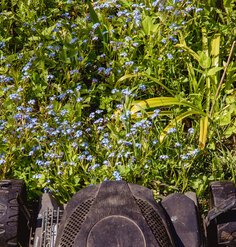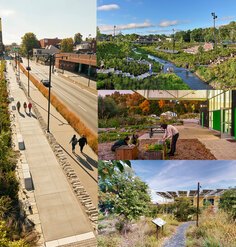Performance Evaluation: U.S. Coast Guard Headquarters
By C. Dylan Reilly, MLA Candidate, University of Maryland
Imagine rising in a translucent elevator above a wooded, stone courtyard when suddenly a bald eagle swoops by, carefully watching for its prey. Imagine walking onto a green roof and disturbing a napping doe, which promptly leaps safely to the ground. Imagine looking up from a babbling fountain surrounded by yellow flowers to see and hear a screeching red-tailed hawk. These almost primal experiences in the built environment are characteristic of the new U.S. Coast Guard Headquarters in Washington, D.C. The landscape encourages these experiences through its incorporation of vegetation from different Maryland regions, like the Coastal Plain, Piedmont, and Blue Ridge.
Last fall Dr. Christopher Ellis asked me if I would like to work with the Landscape Architecture Foundation (LAF) and the General Services Administration to evaluate the performance of this stunning landscape. As a graduate student finishing my first semester I was thrilled to have the opportunity. I come from a geology background, so it was an obvious fit. Through the course of the project, I have spent countless hours reading case studies for precedent and pouring over scientific articles to understand how to develop rigorous metrics. During this process, it quickly became clear how interdisciplinary landscape performance is. As researchers, we need to be able to identify the endangered species flying over our head as much as we need to know how to measure ambient air temperature.
At the U.S. Coast Guard Headquarters, we are looking at a variety of metrics, including biodiversity, carbon sequestration, and courtyard use. We are also observing how different surfaces on-site either contribute to or mitigate the urban heat island effect. To do this, we deployed a series of eight inexpensive temperature loggers, seven on different surfaces and one to measure ambient air temperature in a courtyard.
One of the most exciting temperature comparisons is between the green roof and the black rubber roof. At over 6 acres, the green roof is the third largest in North America, and we hypothesize that its heat island and stormwater benefits are significant. As we analyze the temperature data, we will pay close attention to timing because the magnitude of the urban heat island effect is greatest on clear summer nights.
Some of the most exciting parts of our study are those metrics that involve on-site data collection, case study precedent, and review of scientific literature. Looking back at LAF’s formative A Case Study Method for Landscape Architecture published in 1999, it is impressive how much work LAF, design firms, and their research partners have done in the past 15 years to make case studies a viable way to advance the practice of landscape architecture. As someone just entering the field, landscape performance is an exciting place to be, and I look forward to working to develop more rigorous ways to measure and value designed landscapes.
Research Assistant C. Dylan Reilly is working with Dr. Christopher D. Ellis, Ph.D., Associate Professor in the Department of Plant Sciences & Landscape Architecture at the University of Maryland to evaluate the environmental, social, and economic performance of the landscape at U.S. Coast Guard Headquarters in Washington, D.C.











